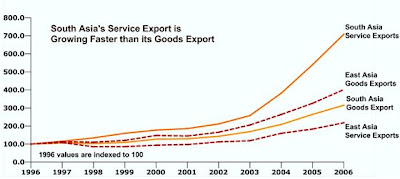Here are the main points from Ejaz Ghani’s presentation:
- Foreign capital inflows—remittances, international syndicated bank lending, private capital investments, and bond issues—to South Asia had surged in recent years, but collapsed in the aftermath of the crisis.
- South Asia, even with lower capital flows, will suffer less compared to other regions because of its particular features because (i) South Asia’s investments are largely driven by domestic savings, (ii) South Asia is unique in attracting capital flows that are less volatile. The region relies more on remittances inflows than for example portfolio flows and bank loans.
- Given the high domestic savings and less dependence on volatile capital inflows, South Asia is likely to bounce back faster.
- (This is probably the most most surprising one for South Asia) Given that the current crisis is synchronized and global in nature, there is less room for an export led recovery.
- South Asia’s economy is largely service driven.Service exports are less volatile compared to goods exports. Globalization of services is still at an early stage.

- A service-led export growth strategy will likely enable South Asia to recover quicker and sustain high growth over the medium term. But not all countries will benefit as there is tremendous diversity within South Asia. (Nepal is clearly the nation which will not see the light of service sector-led growth as this sector is yet to emerge!)
- South Asia is the largest net importer of commodities (food, metal, and oil) in relation to GDP. The sharp decline in commodity prices, especially oil could reduce large commodity-related subsidies. Such savings could be used to finance discretionary fiscal stimulus.
- Recovery will depend on the composition of capital flows, trade, and economic management.
(Usually, when ‘South Asia’ is studied, researchers look at India, Sri Lanka, Maldives, Pakistan and Bangladesh only. They forget about Nepal, Bhutan, and Afghanistan). So, the conclusions and recommendations of these kind of study might not necessarily apply to the neglected economies. Btw, these are also the most poorest ones in the world.)